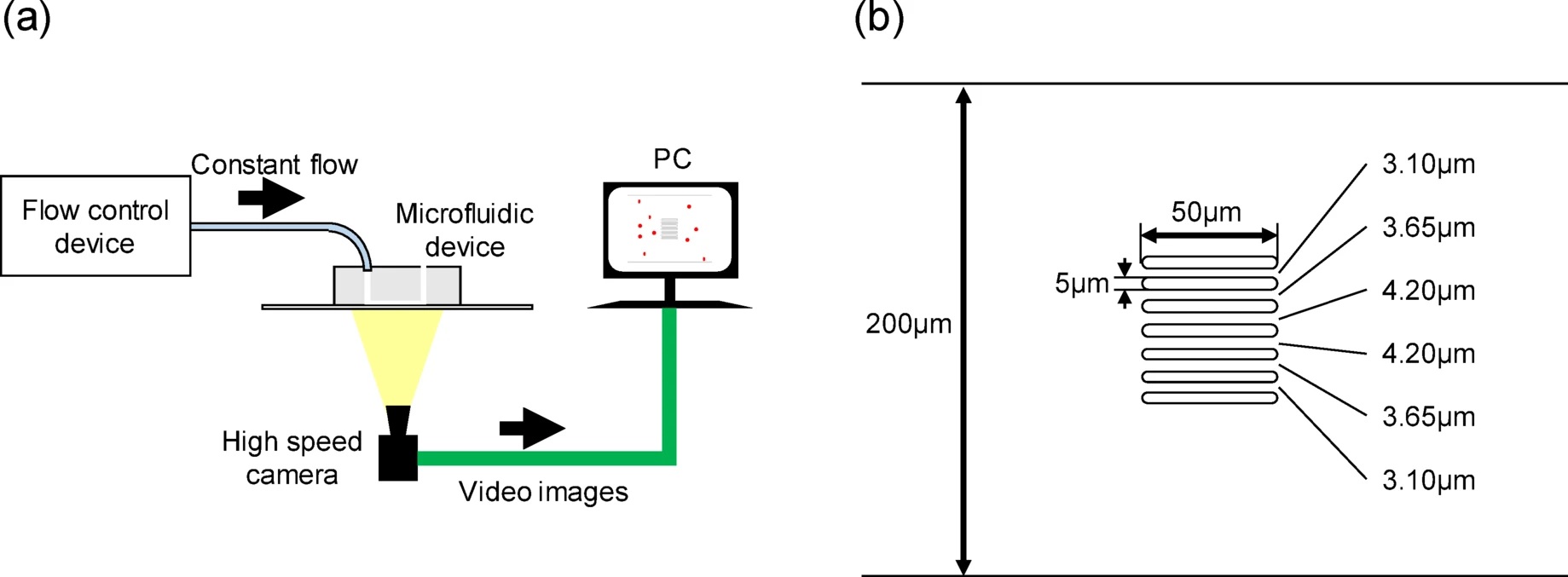
27 Jun Microfluidics Reveal Iron Deficiency Leads to More Deformable Red Blood Cells
Red blood cell (RBC) deformability, the ability of RBCs to squeeze through tiny capillaries, is critical for oxygen delivery and cell longevity. While it is known that RBC deformability changes in many diseases, its behavior in iron deficiency (ID), particularly before the onset of anemia, has been less clear. Conventional wisdom based on older measurement methods has suggested RBCs in ID anemia may become less deformable. To clarify the relationship between iron deficiency and RBC deformability, researchers from Osaka University developed and applied an microfluidic platform serving as an on-chip deformability checker; a microfluidic device that mimics capillary-sized constrictions. They sought to directly observe how RBC deformability correlates with iron status, using a cohort of 120 human participants with varying levels of ferritin and hemoglobin taking advantage of microfluidics technology.
“We aimed to evaluate RBC deformability in ID anemia and investigate the association of RBC deformability with ferritin levels, which are used to diagnose and assess the severity of ID, and RBC parameters, including morphology and internal viscosity, which are important determinants of RBC deformability.”, the authors explained.
The team microfabricated microfluidic chips with constrictions ranging from 3.10 to 4.20 μm, simulating capillary vessels. Washed RBCs from blood samples were suspended with microspheres for flow calibration and passed through the microfluidic device and these microfluidic constrictions under pressure control. High-speed imaging tracked RBC deformation and velocity. A key outcome was the RBC Deformability Index (RDI), calculated based on normalized velocity at a fixed deformation threshold.

“Schematic representation of the microfluidic system for measuring RBC deformability. (a) The microfluidic device is connected to a pressure control system. The pressure control system provides a constant pressure source for stable fluid flow in the microfluidic chip. A high-speed vision camera is installed on the microscope to record images of RBCs and beads. (b) Dimensions of microfluidic passage and constrictions. The microfluidic passage is 200 μm wide and 3.5 μm deep. Six obstacles with 50 μm in length and 5 μm in width are located parallel in the center of the passage to make constrictions between the obstacles. The constriction widths are 3.10, 3.65, 4.20, 4.20, 3.65, and 3.10 μm from top to bottom, respectively.” Reproduced from Kajitani, K., Ohtani, T., Higuchi, R. et al. An on-chip deformability checker demonstrates that the severity of iron deficiency is associated with increased deformability of red blood cells. Sci Rep 15, 19994 (2025). under a Creative Commons Attribution 4.0 International License.
Participants were stratified into four groups: controls, iron-deficient without anemia, iron-deficient with anemia, and non-iron-deficient with anemia. The RBCs were further analyzed for morphological traits (e.g., thickness, aspect ratio) and internal viscosity proxies such as mean corpuscular hemoglobin concentration (MCHC).
The RDI was significantly higher in the iron-deficient groups, with the ID/anemia group showing the greatest deformability. Importantly, RBCs in individuals with iron deficiency, even without anemia, were thinner, more elongated, and had lower internal viscosity. These physical changes were associated with higher deformability. The strongest independent predictor of increased RDI was a low ferritin level (log-transformed), even after adjusting for hemoglobin. This implies that iron deficiency alone, regardless of anemia status, alters RBC mechanical properties.
This microfluidic study demonstrates that RBCs become more deformable with increasing severity of iron deficiency. This change is primarily driven by alterations in RBC shape and reduced internal viscosity. The microfluidic deformability checker allowed for direct, realistic measurements of RBC behavior in capillary-like environments, offering insights into how the body might compensate for impaired erythropoiesis in ID by extending RBC lifespan through enhanced deformability.
“ID correlates with the high deformability of RBCs. This high deformability can be explained by the morphological characteristics and low internal viscosity of RBCs, which are associated with ID. This finding implies that the increased deformability of RBCs in ID may reduce their likelihood of being trapped in interendothelial slits in the spleen, potentially extending RBC lifespan.“, the authors concluded.
Figures are reproduced from Kajitani, K., Ohtani, T., Higuchi, R. et al. An on-chip deformability checker demonstrates that the severity of iron deficiency is associated with increased deformability of red blood cells. Sci Rep 15, 19994 (2025). https://doi.org/10.1038/s41598-025-05483-2 under a Creative Commons Attribution 4.0 International License.
Read the original article: An on-chip deformability checker demonstrates that the severity of iron deficiency is associated with increased deformability of red blood cells
For more insights into the world of microfluidics and its burgeoning applications in biomedical research, stay tuned to our blog and explore the limitless possibilities that this technology unfolds. If you need high quality microfluidics chip for your experiments, do not hesitate to contact us.


